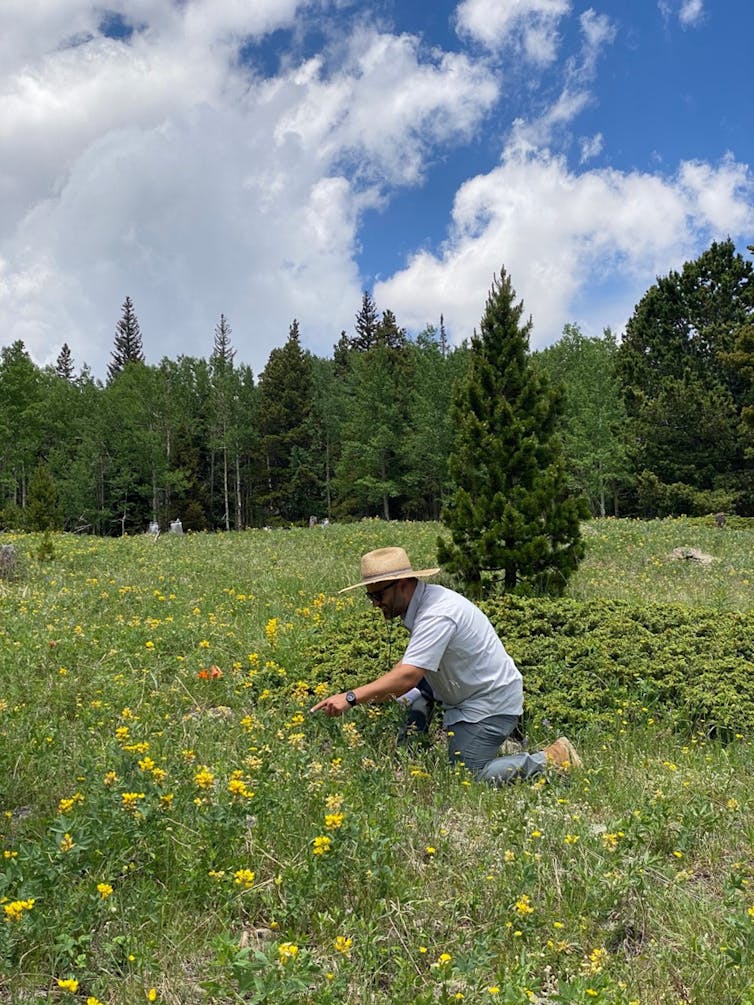I’ve visited the same Rocky Mountain subalpine meadow weekly for a decade of summers looking at plan
Decades-long environmental studies can reveal trends caused by climate change better than projects that last only a year or two.

Imagine a bee crawling into a bright yellow flower.
This simple interaction is something you may have witnessed many times. It is also a crucial sign of the health of our environment – and one I’ve devoted hundreds of hours of field work observing.
Interactions between plants and pollinators help plants reproduce, support pollinator species like bees, butterflies and flies, and benefit both agricultural and natural ecosystems.
These one-on-one interactions occur within complex networks of plants and pollinators.
In my lab at the University of Colorado Boulder, we’re interested in how these networks change over time and how they respond to stressors like climate change. My team emphasizes long-term data collection in hopes of revealing trends that would otherwise be unnoticed.
Working at Elk Meadow
Ten years ago, I began working in Elk Meadow, which is located at 9,500 feet (or 2,900 meters) elevation at the University of Colorado’s Mountain Research Station.
I wanted a local field site that allowed for frequent observations to study the dynamics of plant-pollinator networks. This beautiful subalpine meadow, bursting with wildflowers and just 40 minutes from campus, fit the bill perfectly.
Since 2015, often joined by members of my lab, I have made weekly hikes to Elk Meadow. We visit from the first flower in May to the last in October. We observe pollinators visiting flowers at plots scattered throughout the meadow, walking the periphery to minimize trampling. The morning is the best time to visit because pollinator activity is high and thunderstorms often roll in at midday during the summer in the Rocky Mountains.
Observing the network
Elk Meadow is rich in biodiversity. Over the years, we have observed 7,612 interactions among over 1,038 unique pairs of species. These pairings were made by 310 species of pollinators and 45 species of plants.

Pollinators include not only a wide variety of bees, but also flies, butterflies, beetles and the occasional hummingbird. Expert entomologists help us identify some of the insects.
Plants include species that are widespread, like the common dandelion, and some that are only found in the Rocky Mountains, like the Colorado columbine.
Common but vital
Collecting data in Elk Meadow is fun, but it is also serious science. Our data is useful for understanding the dynamics of plant and pollinator interactions within and across seasons.

For example, we learned which interactions between plants and pollinators are stable and which change over time and space. We consistently observed interactions between generalist species and their many partners over time and in different plots across the meadow.
Generalist species can tolerate a range of environmental conditions, meaning they are more frequently available to interact.
In other words, generalist species are more likely to be alive, active and foraging in the case of pollinators – or flowering in the case of plants – compared with species that can only survive if environmental conditions like temperature, sunlight and rainfall are just right to support them.
Generalist species are vital in networks, but they often don’t receive the same conservation attention as rare species. Even these common species can decline due to environmental changes destabilizing entire ecosystems. Protecting these species is important for maintaining biodiversity.
In it for the long term

As we gather more years of data, our study is becoming increasingly useful for understanding how networks and pollinator populations are changing – especially with signs of climate change increasingly emerging. Most ecological studies are only designed or funded for one or a few years, making our 10-year dataset one of only a few for plant-pollinator networks.
It is only with long-term ecological data that we can detect trends in responses to climate change, particularly because of high year-to-year variability in weather and populations.
The National Science Foundation supports a network of long-term ecological research stations across the U.S., including the Niwot Ridge Long-term Ecological Research Program near Elk Meadow, which is dedicated to the study of high-mountain species and ecosystems.
Colorado’s climate, like much of the world, is experiencing significant changes, such as rising temperatures, earlier snow melt and more late-winter and spring rain instead of snow. These changes lead to earlier water runoff from mountains, drier soils and more severe droughts. These shifts can have important consequences for plants and pollinators, including changes in where species are found, how many there are, and when they flower or forage.
High-elevation plant and pollinator communities may be especially vulnerable to climate change impacts since these areas are experiencing greater temperature increases compared with lower elevations.
We have seen warmer and drier conditions at Elk Meadow. Overlaid in this trend, we have observed annual variation in temperature and drought conditions that can help us understand and predict how different species will fare in a hotter and drier future.
Climate change is a driver of pollinator declines and is predicted to become increasingly important in the coming decades. Immediate threats also include pesticide use, light pollution and the destruction of wild habitats for farming and development.
The state of Colorado recently commissioned a study to gauge the health of Colorado’s native pollinators and make recommendations on how to protect them.
Appreciating the current pollinator landscape
Working at Elk Meadow has provided opportunities for my students to conduct independent research and receive valuable training and mentoring.
Seeing the beauty of the living things in the meadow and observing their cycles inspires my students and me.
Elk Meadow is a place to clear my mind and come up with new research ideas. It is also a place to observe and record how one tiny patch of our planet is changing in reaction to bigger changes happening around it.
Julian Resasco receives funding from the University of Colorado and the National Science Foundation.
Read These Next
Christmas trees are more expensive than ever in Colorado — what gives?
Most Christmas trees are imported from other states, which drives up costs.
Getting peace right: Why justice needs to be baked into ceasefire agreements – including Ukraine’s
Just war theory, a centuries-old field of ethics, deals with how and when to start conflicts. It can…
How the NIH became the backbone of American medical research and a major driver of innovation and ec
The agency’s budget has grown steadily since the 1960s, fueling an industry that creates lifesaving…






